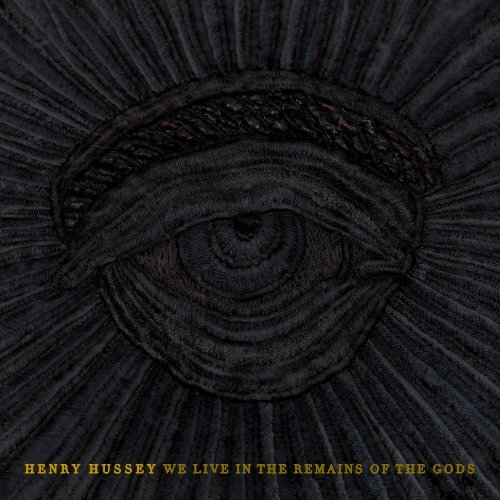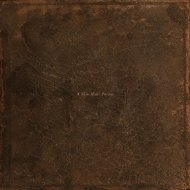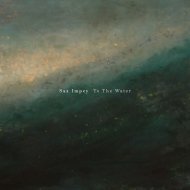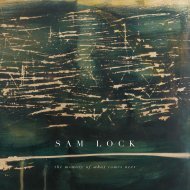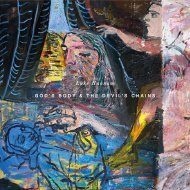Henry Hussey 'We Live in the Remains of the Gods'
Fully illustrated online publication for the solo exhibition 'We Live in the Remains of the Gods' by Henry Hussey at Anima Mundi, St Ives
Fully illustrated online publication for the solo exhibition 'We Live in the Remains of the Gods' by Henry Hussey at Anima Mundi, St Ives
You also want an ePaper? Increase the reach of your titles
YUMPU automatically turns print PDFs into web optimized ePapers that Google loves.
H E N R Y H U S S E Y W E L I V E I N T H E R E M A I N S O F T H E G O D S
A nihilist is a man who judges <strong>of</strong> <strong>the</strong> world<br />
as it is that it ought not to be, and <strong>of</strong> <strong>the</strong><br />
world as it ought to be that it does not<br />
exist. Accord<strong>in</strong>g to this view, our existence<br />
(action, suffer<strong>in</strong>g, will<strong>in</strong>g, feel<strong>in</strong>g) has<br />
no mean<strong>in</strong>g: <strong>the</strong> pathos <strong>of</strong> ‘<strong>in</strong> va<strong>in</strong>’ is <strong>the</strong><br />
nihilists’ pathos – at <strong>the</strong> same time, as<br />
pathos, (<strong>the</strong>re is) an <strong>in</strong>consistency...<br />
Friedrich Nietzsche, “The Will to Power”
“If you’re go<strong>in</strong>g to try, go all <strong>the</strong> way. O<strong>the</strong>rwise,<br />
don’t even start. This could mean los<strong>in</strong>g<br />
girlfriends, wives, relatives and maybe even<br />
your m<strong>in</strong>d. It could mean not eat<strong>in</strong>g for three<br />
or four days. It could mean freez<strong>in</strong>g on a<br />
park bench. It could mean jail. It could mean<br />
derision. It could mean mockery -- isolation.<br />
Isolation is <strong>the</strong> gift. All <strong>the</strong> o<strong>the</strong>rs are a test <strong>of</strong><br />
your endurance, <strong>of</strong> how much you really want to<br />
do it. And, you’ll do it, despite rejection and <strong>the</strong><br />
worst odds. And it will be better than anyth<strong>in</strong>g<br />
else you can imag<strong>in</strong>e. If you’re go<strong>in</strong>g to try, go<br />
all <strong>the</strong> way. There is no o<strong>the</strong>r feel<strong>in</strong>g like that.<br />
You will be alone with <strong>the</strong> gods, and <strong>the</strong> nights<br />
will flame with fire. You will ride life straight<br />
to perfect laughter. It’s <strong>the</strong> only good fight<br />
<strong>the</strong>re is.”<br />
Charles Bukowski, Factotum<br />
<strong>Hussey</strong> states “I have killed <strong>Henry</strong> over and<br />
over aga<strong>in</strong>, because <strong>the</strong> only way to grow as a<br />
person is be<strong>in</strong>g will<strong>in</strong>g to sacrifice what you hold<br />
dear and identify with, to elim<strong>in</strong>ate <strong>the</strong> qualities<br />
which over time get <strong>in</strong> <strong>the</strong> way, stripp<strong>in</strong>g <strong>the</strong> ego<br />
<strong>in</strong> order to progress.”<br />
At a time <strong>of</strong> crisis, a palpable murmur<br />
arises, suggest<strong>in</strong>g to many <strong>of</strong> us that if we<br />
rip down <strong>the</strong> established order perhaps we<br />
could re-form a pure new world <strong>of</strong> optimistic<br />
possibility. Ah, but what happens when we<br />
meet <strong>the</strong> first person who doesn’t agree<br />
with our new world vision? Well, to create<br />
any substantial societal change, first we<br />
probably need to accept and allow for a<br />
dose <strong>of</strong> anarchy, and perhaps a little dash <strong>of</strong><br />
bloodshed. If <strong>the</strong>re are those that stand <strong>in</strong><br />
<strong>the</strong> way <strong>of</strong> <strong>the</strong> potential <strong>of</strong> our utopia, maybe<br />
it’s <strong>of</strong>f to <strong>the</strong> work camps, or perhaps we just<br />
elim<strong>in</strong>ate <strong>the</strong>m and make <strong>the</strong> issue go away…<br />
If you look throughout human history any<br />
significant change, usually results <strong>in</strong> atrocity.<br />
Friedrich Nietzsche approached <strong>the</strong> problem<br />
<strong>of</strong> nihilism as deeply personal, stat<strong>in</strong>g that<br />
<strong>the</strong> predicament <strong>of</strong> <strong>the</strong> modern world is<br />
a problem that has “become conscious” <strong>in</strong><br />
him. Accord<strong>in</strong>g to Nietzsche, it is only<br />
when nihilism is overcome that a culture<br />
can have a true foundation upon which to<br />
thrive. ‘We <strong>Live</strong> <strong>in</strong> <strong>the</strong> Rema<strong>in</strong>s <strong>of</strong> <strong>the</strong> Gods’<br />
alludes to <strong>the</strong> pre-existence <strong>of</strong> our collective<br />
foundation. <strong>Hussey</strong> cites huge rises <strong>in</strong><br />
cases <strong>of</strong> depression result<strong>in</strong>g from personal<br />
isolation as a sickness with<strong>in</strong> our society<br />
and vulnerability <strong>of</strong> our species. “We need<br />
someth<strong>in</strong>g to believe <strong>in</strong>” he states. “Whe<strong>the</strong>r<br />
it’s <strong>the</strong> wea<strong>the</strong>r God, family, mean<strong>in</strong>g, purpose,<br />
sun deity, a man on a cross… hav<strong>in</strong>g belief is<br />
an <strong>in</strong>herent part <strong>of</strong> our humanity. All humans<br />
have a black hole <strong>in</strong>side ourselves, which must<br />
be filled to nullify <strong>the</strong> pa<strong>in</strong>. We have tried, and<br />
largely failed to fill it with consumerism and<br />
capitalism… We all need purpose and mean<strong>in</strong>g<br />
to susta<strong>in</strong> our existence, as that’s <strong>the</strong> only th<strong>in</strong>g<br />
that makes <strong>the</strong> suffer<strong>in</strong>g worthwhile.”<br />
In 2016, <strong>Hussey</strong> began mak<strong>in</strong>g reactionary<br />
work, he states that he had “stopped believ<strong>in</strong>g<br />
<strong>in</strong> what he was say<strong>in</strong>g”. Hav<strong>in</strong>g read a book<br />
about <strong>the</strong> atrocities <strong>of</strong> <strong>the</strong> 20 th century titled<br />
‘Maps <strong>of</strong> Mean<strong>in</strong>g - The Architecture <strong>of</strong> Belief’<br />
by Jordan B Peterson, <strong>the</strong> conclusion that<br />
<strong>the</strong> he came to, was ra<strong>the</strong>r than try<strong>in</strong>g to use<br />
a collective ideology to change <strong>the</strong> world,<br />
<strong>in</strong>stead you change yourself. So you must<br />
attempt to remove all <strong>the</strong> suffer<strong>in</strong>g from<br />
your own existence and build your own life<br />
on solid ground before attempt<strong>in</strong>g wider<br />
change. The immediate result is to help <strong>the</strong><br />
closest people around you, who may <strong>in</strong> turn<br />
be compelled to try to change and alleviate<br />
<strong>the</strong>ir own suffer<strong>in</strong>g and <strong>the</strong>n <strong>in</strong> turn help<br />
o<strong>the</strong>rs, creat<strong>in</strong>g a cha<strong>in</strong> reaction. This form<br />
<strong>of</strong> <strong>in</strong>dividualism has <strong>the</strong> potential to lead to<br />
<strong>the</strong> benefit <strong>of</strong> all. Prior to this po<strong>in</strong>t <strong>Hussey</strong>’s<br />
work could be seen to represent an egoistic<br />
belief that his personal narrative represented<br />
<strong>the</strong> universal. Yet <strong>the</strong> work <strong>in</strong> this exhibition<br />
2
3
<strong>in</strong>dicates a rotation <strong>of</strong> thought, where <strong>the</strong><br />
universal is represented through <strong>the</strong> personal<br />
experience, and becomes an acknowledgement<br />
<strong>of</strong> one’s own humility.<br />
‘We <strong>Live</strong> <strong>in</strong> <strong>the</strong> Rema<strong>in</strong>s <strong>of</strong> <strong>the</strong> Gods’ is loaded<br />
with archetypical and symbolic, cross cultural,<br />
imagery and ritual, which <strong>Hussey</strong> uses as a<br />
way to exam<strong>in</strong>e truth and reveal our shared<br />
foundations. This search runs deep, as <strong>Hussey</strong><br />
suggests that it is someth<strong>in</strong>g we are now<br />
lack<strong>in</strong>g as a society; “when a culture lacks truth<br />
and lies collectively, what typically happens to<br />
it throughout history, is that <strong>the</strong>re is a fall or<br />
flood or destruction. I’m us<strong>in</strong>g this imagery as<br />
a warn<strong>in</strong>g, that when you embrace falsehood,<br />
you’re not just betray<strong>in</strong>g yourself, you are also<br />
putt<strong>in</strong>g society at risk.”<br />
For <strong>Henry</strong>, his form <strong>of</strong> <strong>in</strong>dividualism takes<br />
<strong>the</strong> form <strong>of</strong> sacrifice, which is a central<br />
<strong>the</strong>me to <strong>the</strong> work, that you must be will<strong>in</strong>g<br />
to give everyth<strong>in</strong>g, even <strong>the</strong> most <strong>in</strong>timate<br />
parts <strong>of</strong> yourself, <strong>in</strong> order to obta<strong>in</strong> your<br />
vision. It is a vision explored <strong>in</strong> multi-media,<br />
where each material choice is selected for<br />
its conceptual weight and potential. Part<br />
<strong>of</strong> <strong>the</strong> reason he enjoys work<strong>in</strong>g with craft<br />
mediums, which are technically pr<strong>of</strong>icient<br />
methods, is that <strong>the</strong>y require skilled expertise,<br />
which can <strong>the</strong>n be underm<strong>in</strong>ed or corrupted<br />
with unexpected action or imagery. <strong>Hussey</strong>’s<br />
works are first exquisitally constructed and<br />
<strong>the</strong>n become subjected to irrevocable actions<br />
upon <strong>the</strong>m. Textile is a utilitarian medium<br />
that has been used throughout history to<br />
proclaim and present <strong>the</strong> significant<br />
moments <strong>in</strong> a civilisation. It carries with it<br />
a way to emblazon important messages and<br />
unite towards a common cause. Glass is an<br />
extraord<strong>in</strong>arily physical medium that you<br />
cannot walk away from once <strong>the</strong> process<br />
beg<strong>in</strong>s. Once cooled, it becomes solid and hard<br />
yet when pushed it breaks, an analogy which<br />
fits <strong>the</strong> human condition perfectly. The glass<br />
works (represent<strong>in</strong>g Sa<strong>in</strong>ts and Martyrs) have<br />
been put through extreme acts <strong>of</strong> violence<br />
<strong>in</strong> <strong>the</strong>ir genesis, yet uphold a moral virtue.<br />
The monopr<strong>in</strong>ts developed, and were <strong>in</strong>spired<br />
by, <strong>the</strong> immediacy <strong>of</strong> <strong>the</strong> glass mak<strong>in</strong>g process.<br />
They primarily reference sculpture from<br />
Greek and Roman antiquity, yet are also<br />
seen as various aspects <strong>of</strong> self portrait. The<br />
f<strong>in</strong>ality <strong>of</strong> <strong>the</strong> process, as once it has gone<br />
through <strong>the</strong> press it is done, is appeal<strong>in</strong>g<br />
<strong>in</strong> its honesty, openness and vulnerability.<br />
The film works are expanded from dreams<br />
which have been fused with elements from<br />
mythological and religious stories. <strong>Hussey</strong> is<br />
naked, front and centre <strong>in</strong> <strong>the</strong>se works, yet<br />
he is play<strong>in</strong>g a character and <strong>in</strong>habit<strong>in</strong>g a<br />
role, where universal ideas are represented<br />
through <strong>the</strong> most personal <strong>of</strong> spectrums.<br />
Expand<strong>in</strong>g from his use <strong>of</strong> performance <strong>in</strong><br />
his work, <strong>the</strong>y are captured, yet ephemeral,<br />
which allows him a wider exploration than<br />
<strong>the</strong> physical mediums can allow <strong>in</strong> isolation.<br />
For <strong>Hussey</strong> a commonality between mediums<br />
is a learn<strong>in</strong>g <strong>of</strong>, and expansion beyond, <strong>the</strong><br />
accepted boundaries <strong>of</strong> that medium, to take<br />
it <strong>in</strong> its pure form and brutalise it reveal<strong>in</strong>g<br />
its capabilities, strength and vulnerability.<br />
Beauty and barbarism seem like accurate<br />
representations <strong>of</strong> human duality, and allude<br />
to a blossom<strong>in</strong>g deriv<strong>in</strong>g from pa<strong>in</strong>.<br />
I ask <strong>Henry</strong> what he hopes people will th<strong>in</strong>k<br />
<strong>of</strong> this challeng<strong>in</strong>g exhibition, he answers<br />
“I am will<strong>in</strong>g to alienate everyone because I<br />
know it is right and <strong>the</strong> decisions I am mak<strong>in</strong>g<br />
are <strong>the</strong> correct ones. I th<strong>in</strong>k <strong>the</strong> past few years<br />
have made me far more formidable as an artist.<br />
I th<strong>in</strong>k <strong>the</strong> show is about history and culture<br />
and <strong>the</strong> cyclical nature <strong>of</strong> it and you need to<br />
have respect for <strong>the</strong> past, even when you’re <strong>in</strong><br />
<strong>the</strong> midst <strong>of</strong> heated exchanges, you need to take<br />
a step back and look at <strong>the</strong> wider picture, not<br />
just <strong>of</strong> <strong>the</strong> current situation but how <strong>the</strong> situation<br />
has been played out throughout human history…<br />
I just read that back, and it sounds like I am<br />
talk<strong>in</strong>g about Brexit doesn’t it?!” He isn’t… A<br />
long l<strong>in</strong>e, when followed, leads us from <strong>the</strong><br />
present to <strong>the</strong> orig<strong>in</strong>s <strong>of</strong> our collective and<br />
personal mythology.<br />
Joseph Clarke, 2019<br />
4
5
Bleed Me Dry<br />
Digitally Pr<strong>in</strong>ted L<strong>in</strong>en and Canvas, Dyed Hessian, Dyed Yarn, Bleached Velvet, Screen-Pr<strong>in</strong>t, Embroidery<br />
260 x 130 cm<br />
6
7
8
Idolatry<br />
Screen-Pr<strong>in</strong>ted Flag<br />
190 x 125 cm<br />
9
The Best And Worst Parts Of Ourselves (Diptych)<br />
Screen-Pr<strong>in</strong>ted Flag, Dyed L<strong>in</strong>en, Dyed Yarn, Embroidery<br />
165 x 95 cm each<br />
10
11
12
The Sickness<br />
Screen-Pr<strong>in</strong>ted Flag<br />
145 x 120 cm<br />
13
Bloodl<strong>in</strong>es<br />
Digitally Pr<strong>in</strong>ted Hand Woven Fabric, Dyed Hessian, Dyed Yarn, Screen-Pr<strong>in</strong>t, Embroidery<br />
300 x 130 cm<br />
14
15
16
Deathbed<br />
Altar Cloth, Digitally Pr<strong>in</strong>ted L<strong>in</strong>en, Hessian and Hand Woven Fabric, Dyed L<strong>in</strong>en, Dyed Yarn, Embroidery<br />
240 x 270 cm<br />
17
The Past<br />
Digitally Pr<strong>in</strong>ted L<strong>in</strong>en, Dyed L<strong>in</strong>en, Dyed Yarn, Screen-Pr<strong>in</strong>t, Embroidery, Dyed Rope, Glass, Steel Pole<br />
265 (H) x 145 (W) x 40 (D) cm<br />
18
19
Untitled (Female Torso I)<br />
Black Glass<br />
32 (H) x 17 (W) x 11 (D) cm<br />
20
Untitled (Female Torso II)<br />
Black Glass<br />
33 (H) x 20 (W) x 12 (D) cm<br />
21
Untitled (Black Herma II)<br />
Black Glass<br />
51 (H) x 18 (W) x 19 (D) cm<br />
22
23
24
Untitled (Black Herma I)<br />
Black Glass<br />
51 (H) x 9 (W) x 15 (D) cm<br />
25
Untitled (Black Hermaphrodite I)<br />
Black Glass<br />
32 (H) x 26 (W) x 18 (D) cm<br />
26
27
Untitled (Black Hermaphrodite II)<br />
Black Glass<br />
47 (H) x 21 (W) x 13 (D) cm<br />
28
Untitled (Black Hermaphrodite III)<br />
Black Glass<br />
46 (H) x 18 (W) x 16 (D) cm<br />
29
HENRY HUSSEY<br />
WE LIVE IN THE REMAINS OF THE GODS<br />
“I keep mak<strong>in</strong>g <strong>the</strong> same mistakes.”<br />
This is <strong>the</strong> pivotal l<strong>in</strong>e <strong>in</strong> ‘Change’, <strong>the</strong><br />
two-channel semi-autobiographical short<br />
film <strong>in</strong>cluded <strong>in</strong> <strong>Henry</strong> <strong>Hussey</strong>’s new<br />
solo exhibition ‘We <strong>Live</strong> <strong>in</strong> <strong>the</strong> Rema<strong>in</strong>s <strong>of</strong><br />
<strong>the</strong> Gods’.<br />
<strong>Hussey</strong> is a man animated and susta<strong>in</strong>ed<br />
by an almost megalomaniacal conviction <strong>of</strong><br />
<strong>the</strong> universal nature <strong>of</strong> his own personal<br />
struggle. Is humanity doomed to repeat<br />
its mistakes? He <strong>in</strong>vites us to take that<br />
possibility seriously by look<strong>in</strong>g at <strong>the</strong> world<br />
through <strong>the</strong> lens <strong>of</strong> ‘archetypes’ – <strong>the</strong> Jungian<br />
hypo<strong>the</strong>sis that all humans share a collective<br />
unconscious whose build<strong>in</strong>g blocks can only<br />
be <strong>in</strong>ferred <strong>in</strong>directly from our stories, art,<br />
myths, religions, and dreams.<br />
Some tropes appear aga<strong>in</strong> and aga<strong>in</strong> <strong>in</strong><br />
civilisations across time and place: <strong>the</strong><br />
nourish<strong>in</strong>g mo<strong>the</strong>r, <strong>the</strong> hero, <strong>the</strong> trickster,<br />
<strong>the</strong> strong man, <strong>the</strong> apocalypse, <strong>the</strong> deluge,<br />
<strong>the</strong> creation, <strong>the</strong> ultimate sacrifice, God.<br />
It’s fair to say that Jung’s ideas have been<br />
somewhat superseded <strong>in</strong> <strong>the</strong> day-to-day<br />
practice <strong>of</strong> contemporary psycho<strong>the</strong>rapy,<br />
but never<strong>the</strong>less one possible explanation<br />
for <strong>the</strong> near ubiquity <strong>of</strong> certa<strong>in</strong> motifs and<br />
complexes is that people have an <strong>in</strong>nate<br />
predisposition to respond to, organise and<br />
<strong>in</strong>terpret <strong>the</strong> world <strong>in</strong> a certa<strong>in</strong> way - <strong>the</strong><br />
psychic counterpart <strong>of</strong> <strong>in</strong>st<strong>in</strong>ct, analogous to<br />
Chomsky’s <strong>the</strong>ory <strong>of</strong> <strong>the</strong> language acquisition<br />
device and a Universal Grammar that is<br />
genetic ra<strong>the</strong>r than learned.<br />
It is never totally clear whe<strong>the</strong>r, ultimately,<br />
<strong>Hussey</strong> is an optimist or a pessimist. On <strong>the</strong><br />
one hand, his wad<strong>in</strong>g through <strong>the</strong> detritus <strong>of</strong><br />
half-remembered myths, <strong>in</strong>herited legends<br />
and fragments <strong>of</strong> faded grandeur seems to<br />
be a suggestion that <strong>the</strong> Enlightenment is,<br />
at best, a work <strong>in</strong> progress. On <strong>the</strong> o<strong>the</strong>r<br />
hand, <strong>the</strong>re is <strong>the</strong> glimmer <strong>of</strong> hope that<br />
culture itself is <strong>the</strong> way out <strong>of</strong> <strong>the</strong> cycle<br />
<strong>of</strong> hubris and nemesis. Hav<strong>in</strong>g complexes<br />
is not pathological, as everyone has <strong>the</strong>m.<br />
What is pathological, however, is th<strong>in</strong>k<strong>in</strong>g<br />
that we don’t. Jung clarifies, “Everyone<br />
knows nowadays that people ‘have complexes’.<br />
What is not so well known, though far more<br />
important <strong>the</strong>oretically, is that complexes can<br />
have us.” Perhaps <strong>Hussey</strong>’s message is that<br />
we don’t need to get rid <strong>of</strong> our complexes:<br />
we just need to become consciously aware<br />
<strong>of</strong> <strong>the</strong>m.<br />
Know<strong>in</strong>g oneself is always likely to require<br />
some prolonged self exam<strong>in</strong>ation and an<br />
element <strong>of</strong> delayed gratification. If <strong>the</strong>re is<br />
a convoluted and time-consum<strong>in</strong>g process<br />
for image-mak<strong>in</strong>g <strong>the</strong>n <strong>Hussey</strong> has probably<br />
given it a go. He burst onto <strong>the</strong> art scene<br />
a few years ago with his confrontational<br />
textiles, which, through <strong>the</strong>ir <strong>in</strong>tricate and<br />
labour-<strong>in</strong>tensive nature, have tended to h<strong>in</strong>t<br />
at <strong>the</strong> determ<strong>in</strong>ed, <strong>in</strong>tense, slow-burn<strong>in</strong>g<br />
rage required to see <strong>the</strong>m through. To those<br />
works he has added a sophisticated yet raw,<br />
series <strong>of</strong> glass sculptures and monopr<strong>in</strong>t<br />
draw<strong>in</strong>gs, both <strong>of</strong> which <strong>in</strong>volve a revell<strong>in</strong>g<br />
<strong>in</strong> <strong>the</strong> tension between fits <strong>of</strong> passion,<br />
spontaneity and even violence, and patient<br />
craft skills. The works on paper and <strong>in</strong> glass<br />
share a satisfy<strong>in</strong>gly complementary sense <strong>of</strong><br />
translucent solidity arrived at by accretion<br />
<strong>of</strong> marks and material. In <strong>the</strong> same way<br />
that <strong>Hussey</strong>’s macho sew<strong>in</strong>g deliberately<br />
plays aga<strong>in</strong>st <strong>the</strong> expectations <strong>of</strong> gender<br />
constructs, so too do <strong>the</strong>se gorgeous glass<br />
forms, tempt<strong>in</strong>g <strong>the</strong> viewer <strong>in</strong>to categoris<strong>in</strong>g<br />
<strong>the</strong>m with Jean Paul Gaultier’s fragrance<br />
30
ottle paradigms <strong>of</strong> ‘homme’ and ‘femme’,<br />
while embody<strong>in</strong>g a fluidity that speaks to a<br />
more complex reality.<br />
There is significant unwelcome pressure on<br />
artists work<strong>in</strong>g today to rise to this historical<br />
moment and make expressly ‘political’ o r,<br />
even worse, ‘useful’ art. A couple <strong>of</strong> years<br />
ago, <strong>Henry</strong> made <strong>the</strong> deliberate decision to<br />
turn away from <strong>the</strong> autobiographical and<br />
self-<strong>in</strong>dulgent <strong>in</strong> favour <strong>of</strong> a more literal<br />
commentary on current affairs – someth<strong>in</strong>g<br />
he now feels has not dated well. ‘Idolatry’<br />
is a work which purges one such ‘mistake’<br />
by condemn<strong>in</strong>g <strong>the</strong> old work to <strong>the</strong> verso,<br />
flipped and replaced with a form <strong>of</strong> self<br />
portrait and with it an <strong>in</strong>sight borrowed from<br />
second-wave fem<strong>in</strong>ists that <strong>the</strong> personal is<br />
political because <strong>the</strong> person is political. ‘The<br />
Best And Worst Parts Of Ourselves’ diptych<br />
makes even more ambiguous use <strong>of</strong> <strong>the</strong> limp<br />
polyester Union flags that punctuate <strong>the</strong> high<br />
street <strong>in</strong> <strong>Hussey</strong>’s home town <strong>of</strong> Weybridge<br />
with plastic patriotism. The Masonic Eye <strong>of</strong><br />
Providence atop both <strong>of</strong> <strong>the</strong> figures creates<br />
a cyclops common to tales from Od<strong>in</strong> to <strong>the</strong><br />
Odyssey and a host <strong>of</strong> places a long way from<br />
leafy Surrey.<br />
By wrestl<strong>in</strong>g with <strong>the</strong> archetypal patterns<br />
through <strong>the</strong> symbols <strong>the</strong>y manifest <strong>in</strong> <strong>the</strong><br />
psyche, <strong>Hussey</strong> is grasp<strong>in</strong>g at an expansion<br />
<strong>of</strong> consciousness. Such an expansion, Jung<br />
believed, was <strong>of</strong> paramount importance,<br />
for as he put it, “Man’s task is…to become<br />
conscious <strong>of</strong> <strong>the</strong> contents that press upward<br />
from <strong>the</strong> unconscious. […] As far as we can<br />
discern, <strong>the</strong> sole purpose <strong>of</strong> human existence is<br />
to k<strong>in</strong>dle a light <strong>in</strong> <strong>the</strong> darkness <strong>of</strong> mere be<strong>in</strong>g.”<br />
And that’s also <strong>the</strong> th<strong>in</strong>g about mistakes – if<br />
you throw <strong>the</strong>m on <strong>the</strong> fire <strong>the</strong>y’ll generate<br />
light for you.<br />
Jon Sharples, 2019<br />
Jon Sharples is an art lawyer, broadcaster<br />
and <strong>in</strong>dependent curator. He is on <strong>the</strong> boards<br />
<strong>of</strong> Block 336 and <strong>the</strong> <strong>Live</strong>rpool Biennial.<br />
31
The All See<strong>in</strong>g Eye<br />
Oil-Based Monotype on Paper<br />
30 x 21 cm<br />
32
33
Vessel<br />
Oil-Based Monotype on Paper<br />
30 x 21 cm<br />
34
Warrior<br />
Oil-Based Monotype on Paper<br />
30 x 21 cm<br />
35
Buried I<br />
Oil-Based Monotype on Paper<br />
30 x 28 cm<br />
36
37
Buried II<br />
Oil-Based Monotype on Paper<br />
30 x 28 cm<br />
38
Buried III<br />
Oil-Based Monotype on Paper<br />
30 x 28 cm<br />
39
Buried IV<br />
Oil-Based Monotype on Paper<br />
30 x 28 cm<br />
40
Buried V<br />
Oil-Based Monotype on Paper<br />
30 x 28 cm<br />
41
Buried VI<br />
Oil-Based Monotype on Paper<br />
30 x 28 cm<br />
42
Buried VII<br />
Oil-Based Monotype on Paper<br />
30 x 28 cm<br />
43
Goddess<br />
Oil-Based Monotype on Paper<br />
42 x 30 cm<br />
44
45
Implement<br />
Oil-Based Monotype on Paper<br />
42 x 30 cm<br />
46
Medusa<br />
Oil-Based Monotype on Paper<br />
42 x 30 cm<br />
47
Shroud<br />
Oil-Based Monotype on Paper<br />
42 x 30 cm<br />
48
The Great Man<br />
Oil-Based Monotype on Paper<br />
42 x 30 cm<br />
49
50
Marysas<br />
Oil-Based Monotype on Paper<br />
76 x 56 cm<br />
51
Prome<strong>the</strong>us<br />
Oil-Based Monotype on Paper<br />
76 x 56 cm<br />
52
53
54
Post-Coital<br />
Oil-Based Monotype on Paper<br />
76 x 56 cm<br />
55
Biography<br />
‘We <strong>Live</strong> <strong>in</strong> <strong>the</strong> Rema<strong>in</strong>s <strong>of</strong> <strong>the</strong> Gods’<br />
is <strong>Henry</strong> <strong>Hussey</strong>’s most ambitious solo<br />
exhibition to date. It is his second solo<br />
exhibition at Anima Mundi follow<strong>in</strong>g ‘You<br />
Cant Outrun This’ <strong>in</strong> 2017.<br />
<strong>Hussey</strong> is a British artist born <strong>in</strong> London<br />
<strong>in</strong> 1990 where he still resides. His artworks<br />
are emotionally raw, created primarily<br />
through <strong>the</strong> paradoxically laboured and<br />
<strong>in</strong>tricate mediums. His textiles utilise a<br />
collage technique <strong>of</strong> embroidery, appliqué,<br />
digital pr<strong>in</strong>t<strong>in</strong>g, and silkscreen<strong>in</strong>g. He<br />
<strong>of</strong>ten uses v<strong>in</strong>tage fabrics that imbue his<br />
artworks with a physical and symbolic<br />
weight, weav<strong>in</strong>g history <strong>in</strong>to his works.<br />
<strong>Hussey</strong> draws <strong>in</strong>spiration, particularly <strong>in</strong><br />
his word based pieces, from historical<br />
union banners ak<strong>in</strong> to those used<br />
dur<strong>in</strong>g <strong>the</strong> British m<strong>in</strong>ers’ strikes, for<br />
<strong>the</strong>ir palpable conviction and guttural<br />
impact. Whe<strong>the</strong>r through an expand<strong>in</strong>g<br />
vocabulary <strong>of</strong> quasi-mythological symbols,<br />
or embroidered l<strong>in</strong>es <strong>of</strong> text extracted<br />
from weighted performative situations,<br />
he explores both personal, national and<br />
universal identity, <strong>of</strong>ten <strong>in</strong> response to<br />
aggravat<strong>in</strong>g relationships and events. The<br />
dramatic and <strong>in</strong>tense impression created<br />
by <strong>the</strong>se works is heightened by a vibrant<br />
and bold palette, which is used to both<br />
re<strong>in</strong>force its narrative as well as underl<strong>in</strong>e<br />
<strong>the</strong> labour-<strong>in</strong>tensive aspect <strong>of</strong> his practice.<br />
The resultant larger-than-life scale<br />
artworks have a command<strong>in</strong>g presence,<br />
both reverential and awe-<strong>in</strong>spir<strong>in</strong>g.<br />
Fur<strong>the</strong>r developments have ensued with<br />
o<strong>the</strong>r materials <strong>in</strong>clud<strong>in</strong>g glass, bronze<br />
and monopr<strong>in</strong>t reveal<strong>in</strong>g a deeper concern<br />
with control and chaos and <strong>the</strong> sweet spot<br />
<strong>in</strong> between <strong>the</strong>se two dist<strong>in</strong>ctive states.<br />
<strong>Hussey</strong> studied Textiles at Chelsea College<br />
<strong>of</strong> Art before complet<strong>in</strong>g an MA <strong>in</strong> Textiles<br />
at <strong>the</strong> Royal College <strong>of</strong> Art. His work is<br />
widely respected and has been exhibited<br />
<strong>in</strong> notable exhibitions <strong>in</strong>clud<strong>in</strong>g The<br />
Textiel Biennale 2017 at Museum Rijswijk<br />
<strong>in</strong> <strong>the</strong> Hague, a solo presentation at Art<br />
Central <strong>in</strong> Hong Kong, <strong>the</strong> Bloomberg New<br />
Contemporaries <strong>in</strong> 2014 at <strong>the</strong> Institute<br />
<strong>of</strong> Contemporary Art <strong>in</strong> London, <strong>the</strong><br />
Royal Academy London and Volta New<br />
York and <strong>the</strong> Young Talent Contemporary<br />
Prize at <strong>the</strong> Ingram Collection <strong>in</strong> 2016.<br />
<strong>Hussey</strong> has participated <strong>in</strong> residencies<br />
at La Vallonea, Tuscany, Italy <strong>in</strong> 2018 and<br />
will participate <strong>in</strong> a residency at Palazzo<br />
Monti, Milan <strong>in</strong> 2020. His work is held <strong>in</strong><br />
collections worldwide <strong>in</strong>clud<strong>in</strong>g Simmons<br />
& Simmons, Hogan Lovells, The Groucho<br />
Club and Soho House.<br />
Self-Portrait<br />
Oil-Based Monotype on Paper . 76 x 56 cm<br />
56
57
58
Zennor<br />
Digital Video<br />
Duration : 9 m<strong>in</strong>utes<br />
59
Change<br />
Digital Video<br />
Duration : 11 m<strong>in</strong>utes<br />
60
61
Published by Anima Mundi to co<strong>in</strong>cide with <strong>Henry</strong> <strong>Hussey</strong> ‘We <strong>Live</strong> <strong>in</strong> <strong>the</strong> Rema<strong>in</strong>s <strong>of</strong> <strong>the</strong> Gods’<br />
All rights reserved. No part <strong>of</strong> this publication may be reproduced, stored <strong>in</strong> a retrieval system or transmitted <strong>in</strong> any form or<br />
by any means electronic, mechanical, photocopy<strong>in</strong>g, record<strong>in</strong>g or o<strong>the</strong>rwise without <strong>the</strong> prior permission <strong>of</strong> <strong>the</strong> publishers<br />
Anima Mundi . Street-an-Pol . St. Ives . Cornwall . +44 (0)1736 793121 . mail@animamundigallery.com . www.animamundigallery.com
www.animamundigallery.com


